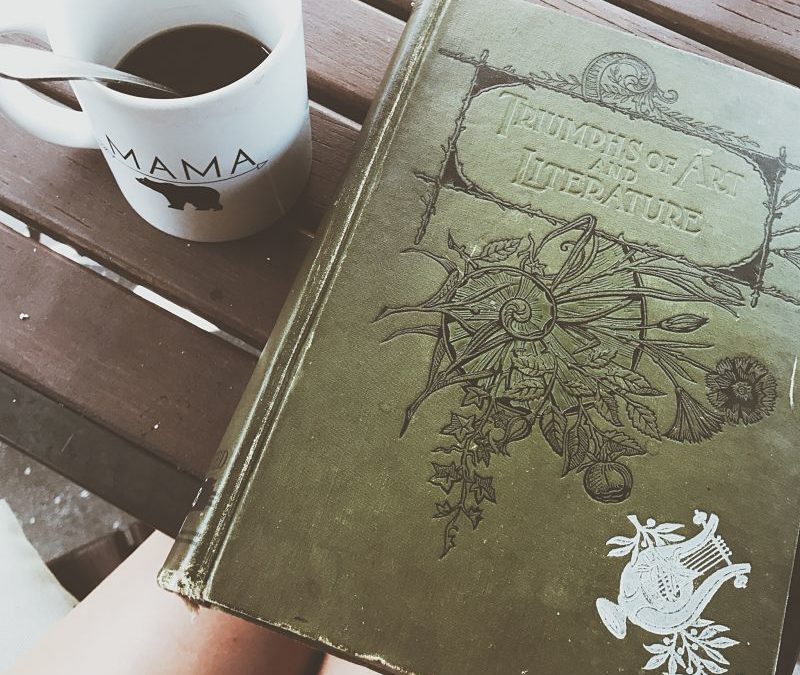I quote from my big green book quite frequently on Instagram. I love this old book. I like to think that it was just waiting for me to find it, all these years, as it sat, in the second row of books, on the back wall, at the used book shop. It was published in 1883. The version I have was revised in 1894. Sometime in the 1960’s, possibly before and after, it sat on the shelves of the Toledo Catholic Library. I also know, due to the stamps located on the inside front cover that it traveled to the Newman Foundation Library in Bowling Green Ohio.
My big green book saw the hands of many. It also saw their pain. As I was reading through the section “Comforting Thoughts”, I came across a poem on the loss of a child. Near the binding of the book was a lock of braided hair. I can only assume it was from a child that was lost. I can also only assume that a mother, someone just like me, stared down and poured out her loss as she read over the words in front of her.
I think about that mother every time I search through the pages of my treasure, and I don’t ever dare remove the lock of hair from her baby.
I also fell in love with Triumps of Art and Literature (the actual title of the big green book) for its cover art.1 It can be seen in the photo above.
My husband and I watch this show called Orphan Black.2 If you haven’t seen it, just stop reading this and go watch it. Tatiana Maslany is probably the most gifted actress I have watched and one of the many characters she plays is Cosima Niehaus.
As we were watching one night, Cosima discloses the reason for her nautical/seashell looking tattoo. She says it is a, “mathematical pattern that repeats itself in nature. In flower petals, and honey bees, and you know, the stars in the galaxy, and in every molecule of our DNA.”
I was fascinated. I immediately turned to Google, and it turns out that this mathematical pattern is called, The Fibonacci Sequence. The sequence/pattern goes something like this: 1, 1, 2, 3, 5, 8, 13, 21, 34, 55… If you look at these numbers, the first and second add to the third (1 + 1 = 2), the third and the fourth to the fifth (2 + 3 = 5), and on and on we go.
When you plot it out visually, it looks like the seashell pattern you see on the cover of my big green book and Cosima’s tattoo. It also can be seen, as Cosima explains, all over nature. Every flower has petals that fall into the sequence. The pattern can be found in sunflowers, pinecones, shells, galaxies, reproduction, faces, fingers, insect flight patterns, and ladies, it is even in our uteruses. 3
The one part I didn’t buy was that it could be found in our DNA. The golden ratio (another name for the sequence) is, however, indeed found in the spiraling of our DNA.
Ok, so I know it seems like I got all nerdy, but join me for just a second, would you, and consider how beautiful this is! You know how your friend that went to the psych fest came back looking red eyed, weird, and saying things like, “the lines were blurred and everything became one”. What if it kind of all was?
What if there is actually a scientific fingerprint that connects us all?
In my struggle with chronic disease, anxiety, and depression, I found that the turning points in my healing, were the times I sat outside in nature and the times I found other people going through the same trials as myself, or simply being with people I loved.
Maybe we are all drawn to the Fibonacci Sequence in one another. Maybe we were all created with something so tiny that actually represents something quite large. Maybe you believe that it was just how nature unraveled, but I think it is evidence that something greater knits us all together.
I mourn with the mom who lost her baby and stole away his lock of hair in the book that I now own, because we were created with the same thread. It holds us together physically and it holds us together in an entirely non-physical dimension.
Is it possible that in order to heal, we need to connect: with ourselves, with nature, and with others?
We can try and say that we are different from one another. We can demonize one another and we can push each other away, It doesn’t matter, because we are all connected by that same thread, and it’s not just a feeling; it’s a mathematical sequence.
I am with you in your struggle. We are all a part of this beautiful, scary place together. And when we step outside and feel ourselves come alive, or fall into the arms of a friend and feel our pain becoming theirs, at least now we know there may be a scientific explanation, in the most mystical way.
1 Williams, A.L. (1894). Triumph of art and literature: A collection of the favorite poems of all times. Chicago, IL: International Publishing Company.
2 Fawcett, J. (Director), (2013-2017). Orphan Black [Television series]. BBC America.
3 Retrieved September 21, 2017 from http://jwilson.coe.uga.edu/emat6680/parveen/fib_nature.htm

